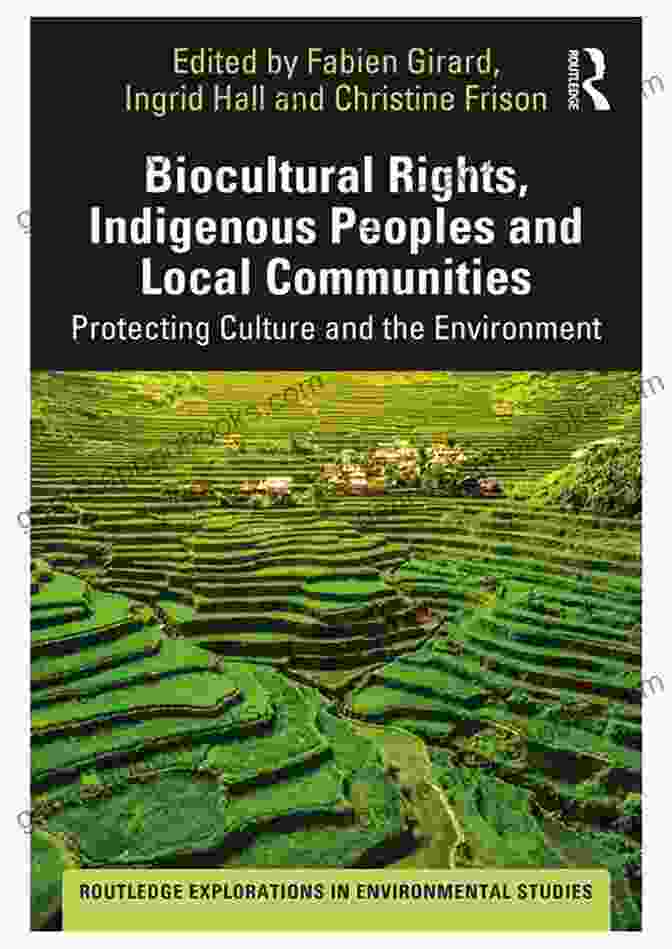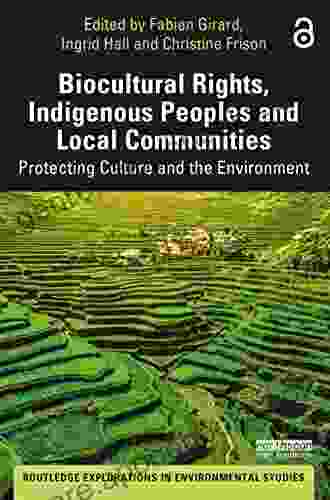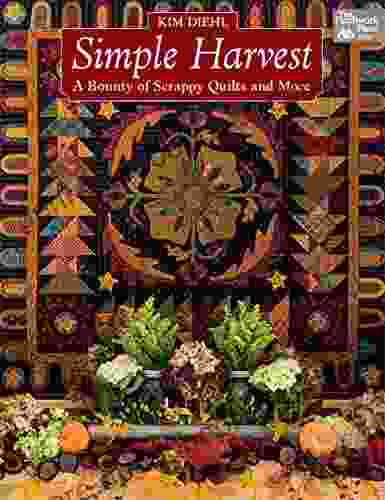Biocultural Rights: Empowering Indigenous Peoples and Local Communities


The rich tapestry of life on Earth is not just a matter of species and ecosystems. It is also about the intricate relationships between people and their environment. For indigenous peoples and local communities, these relationships are not just a source of sustenance, but also a matter of cultural identity and spiritual significance. This profound connection between people and place is known as "biocultural diversity."
5 out of 5
| Language | : | English |
| File size | : | 4921 KB |
| Text-to-Speech | : | Enabled |
| Enhanced typesetting | : | Enabled |
| Word Wise | : | Enabled |
| Print length | : | 371 pages |
Sadly, biocultural diversity is facing numerous threats from globalization, climate change, and other factors. As a result, indigenous peoples and local communities are facing increasing challenges to their rights and livelihoods.
What are Biocultural Rights?
Biocultural rights are the rights of indigenous peoples and local communities to maintain and develop their unique relationships with their lands, territories, and natural resources. These rights are based on the recognition that indigenous peoples and local communities have a special connection to their environment and that this connection is essential for their cultural and spiritual well-being.
Biocultural rights include the right to:
* Access and use traditional lands and territories * Protect and manage natural resources * Practice traditional knowledge and customary laws * Participate in decision-making about land and resource use
Why are Biocultural Rights Important?
Biocultural rights are important for several reasons:
* Cultural Identity: Biocultural rights help to preserve the cultural identity of indigenous peoples and local communities. By maintaining their traditional relationships with their environment, these communities can pass on their knowledge and traditions to future generations. * Livelihoods: Biocultural rights support the livelihoods of indigenous peoples and local communities. By allowing these communities to access and use their traditional lands and resources, they can continue to practice their traditional ways of life, such as fishing, hunting, and farming. * Biodiversity Conservation: Indigenous peoples and local communities are often the best stewards of their environment. By protecting their biocultural rights, we can also help to protect the world's biodiversity. Indigenous peoples and local communities have a wealth of knowledge about how to manage and conserve their natural resources. This knowledge is essential for the conservation of biodiversity and the planet as a whole.
Threats to Biocultural Rights
Biocultural rights are facing numerous threats, including:
* Globalization: Globalization is leading to the loss of traditional lands and resources, as well as the erosion of traditional knowledge and customary laws. * Climate Change: Climate change is having a devastating impact on indigenous peoples and local communities, as it is disrupting their traditional livelihoods and cultural practices. * Extractive Industries: Extractive industries, such as mining, logging, and oil and gas development, are often carried out without the consent of indigenous peoples and local communities, and can have a devastating impact on their environment and livelihoods.
The Book: Biocultural Rights: Indigenous Peoples and Local Communities
The book "Biocultural Rights: Indigenous Peoples and Local Communities" provides a comprehensive overview of the concept of biocultural rights. The book is written by a team of experts from around the world and includes case studies from a variety of countries.
The book covers a wide range of topics, including:
* The history of biocultural rights * The legal basis for biocultural rights * The threats to biocultural rights * Strategies for protecting biocultural rights
The book is an essential resource for anyone who is interested in indigenous peoples, local communities, and the environment. It is also a valuable tool for policymakers, lawyers, and activists who are working to protect biocultural rights.
Biocultural rights are essential for the well-being of indigenous peoples and local communities. By recognizing and protecting these rights, we can help to ensure that these communities can continue to live in harmony with their environment and pass on their knowledge and traditions to future generations.
The book "Biocultural Rights: Indigenous Peoples and Local Communities" is a valuable resource for anyone who is interested in this important topic. The book provides a comprehensive overview of the concept of biocultural rights and includes case studies from around the world. It is an essential resource for policymakers, lawyers, activists, and anyone else who is working to protect biocultural rights.
5 out of 5
| Language | : | English |
| File size | : | 4921 KB |
| Text-to-Speech | : | Enabled |
| Enhanced typesetting | : | Enabled |
| Word Wise | : | Enabled |
| Print length | : | 371 pages |
Do you want to contribute by writing guest posts on this blog?
Please contact us and send us a resume of previous articles that you have written.
 Book
Book Novel
Novel Page
Page Chapter
Chapter Text
Text Story
Story Genre
Genre Reader
Reader Library
Library Paperback
Paperback E-book
E-book Magazine
Magazine Newspaper
Newspaper Paragraph
Paragraph Sentence
Sentence Bookmark
Bookmark Shelf
Shelf Glossary
Glossary Bibliography
Bibliography Foreword
Foreword Preface
Preface Synopsis
Synopsis Annotation
Annotation Footnote
Footnote Manuscript
Manuscript Scroll
Scroll Codex
Codex Tome
Tome Bestseller
Bestseller Classics
Classics Library card
Library card Narrative
Narrative Biography
Biography Autobiography
Autobiography Memoir
Memoir Reference
Reference Encyclopedia
Encyclopedia Scott Dodson
Scott Dodson Laura Shohet Carver
Laura Shohet Carver Trevor Salloum
Trevor Salloum Robert Kelchen
Robert Kelchen Soweto Satir
Soweto Satir N T Narbutovskih
N T Narbutovskih Davis W Houck
Davis W Houck Suzanne Clothier
Suzanne Clothier Mary Sue Welsh
Mary Sue Welsh Margaret Read Macdonald
Margaret Read Macdonald Peter L Bergen
Peter L Bergen Lea M Mcgee
Lea M Mcgee Mande Matthews
Mande Matthews Lian Hearn
Lian Hearn Susan Rose Ackerman
Susan Rose Ackerman Nicholas Starks
Nicholas Starks Ward Serrill
Ward Serrill Andrew Sanders
Andrew Sanders Roger Scruton
Roger Scruton Michael Harrington
Michael Harrington
Light bulbAdvertise smarter! Our strategic ad space ensures maximum exposure. Reserve your spot today!

 Albert ReedUnlock Your Latent Power: A Journey of Self-Discovery with "How To Tap Into...
Albert ReedUnlock Your Latent Power: A Journey of Self-Discovery with "How To Tap Into...
 Gregory WoodsUnveiling the Turbulent History of San Antonio Gangs: A Comprehensive Look at...
Gregory WoodsUnveiling the Turbulent History of San Antonio Gangs: A Comprehensive Look at... Robert Louis StevensonFollow ·16.7k
Robert Louis StevensonFollow ·16.7k Hugo CoxFollow ·4.1k
Hugo CoxFollow ·4.1k Ray BlairFollow ·14k
Ray BlairFollow ·14k Thomas PowellFollow ·8.1k
Thomas PowellFollow ·8.1k Eric NelsonFollow ·18.2k
Eric NelsonFollow ·18.2k John GrishamFollow ·19.2k
John GrishamFollow ·19.2k Abe MitchellFollow ·19.5k
Abe MitchellFollow ·19.5k Junichiro TanizakiFollow ·11.3k
Junichiro TanizakiFollow ·11.3k

 Finn Cox
Finn CoxCarmen Suite For Flute Quartet (G Alto Flute) ( Carmen...
Experience the Magic of...

 Andy Cole
Andy ColeUncover Hidden Truths: A Comprehensive Guide to Detecting...
: The Silent...

 Ken Simmons
Ken SimmonsUnleash Your Potential: Transform Frustration and...
Are you tired of feeling...

 Rick Nelson
Rick NelsonHard To Kill: A Gripping Thriller That Will Keep You on...
Tom Rollins is a...

 Ivan Turner
Ivan TurnerUnleash the Power of Your Breath: Discover Breath...
In the tapestry of life, where stress and...
5 out of 5
| Language | : | English |
| File size | : | 4921 KB |
| Text-to-Speech | : | Enabled |
| Enhanced typesetting | : | Enabled |
| Word Wise | : | Enabled |
| Print length | : | 371 pages |










